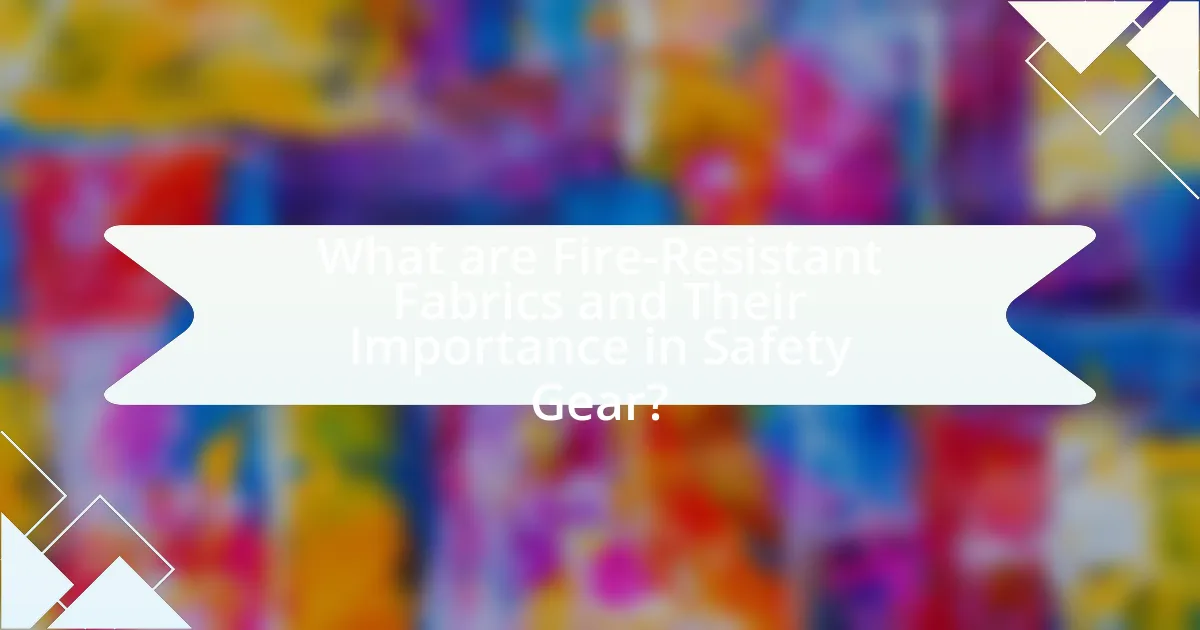Fire-resistant fabrics are specialized materials designed to withstand high temperatures and resist ignition, playing a critical role in safety gear for hazardous environments such as firefighting and industrial work. This article explores the composition, functionality, and importance of these fabrics, highlighting materials like aramid and treated cotton, as well as advancements in technology that enhance their protective qualities. It also addresses the regulatory landscape influencing fabric development, the challenges manufacturers face, and best practices for selecting and maintaining fire-resistant gear. The discussion underscores the significance of fire-resistant fabrics in reducing workplace injuries and fatalities related to fire hazards.

What are Fire-Resistant Fabrics and Their Importance in Safety Gear?
Fire-resistant fabrics are materials specifically engineered to withstand high temperatures and resist ignition, making them crucial for safety gear used in hazardous environments. These fabrics are often made from fibers such as aramid, modacrylic, or treated cotton, which provide thermal protection and reduce the risk of burns in situations like firefighting, industrial work, and electrical maintenance. The importance of fire-resistant fabrics in safety gear is underscored by their ability to protect wearers from severe injuries and fatalities caused by fire-related incidents, as evidenced by regulations such as NFPA 2112, which sets standards for flame-resistant clothing in the workplace.
How do fire-resistant fabrics protect against heat and flames?
Fire-resistant fabrics protect against heat and flames by incorporating specialized fibers and treatments that inhibit ignition and reduce heat transfer. These fabrics are often made from materials such as aramid, modacrylic, or treated cotton, which are designed to withstand high temperatures and resist burning. For instance, aramid fibers, commonly used in fire-resistant clothing, can withstand temperatures up to 370 degrees Celsius without melting or igniting. Additionally, many fire-resistant fabrics undergo chemical treatments that enhance their flame-retardant properties, ensuring they do not catch fire easily and provide a barrier against heat. This combination of material properties and treatments effectively minimizes the risk of burns and injuries in hazardous environments.
What materials are commonly used in fire-resistant fabrics?
Common materials used in fire-resistant fabrics include aramid fibers, such as Kevlar and Nomex, as well as treated cotton and polyester blends. Aramid fibers are known for their high heat resistance and strength, making them ideal for protective clothing in hazardous environments. Treated cotton and polyester blends are often used for their comfort and breathability while still providing a degree of flame resistance. These materials are extensively tested and certified to meet safety standards, ensuring their effectiveness in protecting against fire hazards.
How do these materials enhance safety in hazardous environments?
Fire-resistant fabrics enhance safety in hazardous environments by providing thermal protection and reducing the risk of burns. These materials are engineered to withstand high temperatures and resist ignition, which is critical in settings such as firefighting, industrial work, and electrical maintenance. For instance, fabrics made from aramid fibers, like Kevlar, can endure extreme heat and are often used in protective clothing to shield workers from flames and heat exposure. Studies have shown that the use of fire-resistant materials can significantly lower the incidence of burn injuries, thereby improving overall safety in environments where fire hazards are prevalent.
Why is the development of fire-resistant fabrics crucial for safety gear?
The development of fire-resistant fabrics is crucial for safety gear because these materials significantly reduce the risk of burns and injuries in hazardous environments. Fire-resistant fabrics are engineered to withstand high temperatures and prevent ignition, providing essential protection for workers in industries such as firefighting, manufacturing, and oil and gas. According to the National Fire Protection Association, approximately 3,390 civilian deaths occur annually due to fire-related incidents, highlighting the importance of protective gear that can mitigate such risks. By incorporating fire-resistant fabrics into safety gear, organizations can enhance worker safety and comply with industry regulations, ultimately saving lives and reducing workplace injuries.
What risks do workers face without proper fire-resistant gear?
Workers face severe risks such as burns, injuries, and fatalities without proper fire-resistant gear. The absence of adequate protection increases the likelihood of exposure to flames and high temperatures, which can lead to third-degree burns and other life-threatening injuries. According to the National Fire Protection Association, in 2019, there were over 3,000 fire-related injuries in the workplace, highlighting the critical need for fire-resistant clothing to mitigate these dangers. Additionally, workers may experience long-term health effects, including respiratory issues from inhaling smoke and toxic fumes, further emphasizing the importance of appropriate safety gear in hazardous environments.
How have regulations influenced the development of these fabrics?
Regulations have significantly influenced the development of fire-resistant fabrics for safety gear by establishing safety standards that manufacturers must meet. For instance, the National Fire Protection Association (NFPA) sets guidelines such as NFPA 1971, which specifies performance requirements for fire service personal protective clothing. Compliance with these regulations drives innovation in fabric technology, leading to the creation of advanced materials like Nomex and Kevlar, which offer enhanced thermal protection and durability. Additionally, the Occupational Safety and Health Administration (OSHA) mandates the use of flame-resistant clothing in certain work environments, further pushing manufacturers to develop fabrics that not only meet regulatory standards but also improve worker safety and comfort.

What are the Key Innovations in Fire-Resistant Fabric Technology?
Key innovations in fire-resistant fabric technology include the development of inherently flame-retardant fibers, advanced coatings, and nanotechnology applications. Inherently flame-retardant fibers, such as aramid and modacrylic, provide built-in protection against flames without the need for chemical treatments, ensuring durability and effectiveness. Advanced coatings, like intumescent and silicone-based finishes, enhance the fire resistance of conventional fabrics, allowing for greater versatility in applications. Additionally, nanotechnology has enabled the creation of fabrics that can self-extinguish and resist high temperatures, significantly improving safety standards in protective gear. These innovations are supported by research indicating that fabrics incorporating these technologies can withstand extreme conditions while maintaining comfort and breathability for users.
How have advancements in technology improved fire-resistant fabrics?
Advancements in technology have significantly improved fire-resistant fabrics by enhancing their thermal protection, durability, and comfort. Innovations such as the development of inherently flame-resistant fibers, like aramid and modacrylic, provide superior heat resistance and self-extinguishing properties. Additionally, advancements in nanotechnology have led to the creation of coatings that increase the fabric’s resistance to heat and flames while maintaining breathability. Research indicates that these technological improvements have resulted in fabrics that can withstand higher temperatures and longer exposure to flames, thereby increasing safety for users in hazardous environments.
What role do nanotechnology and chemical treatments play?
Nanotechnology and chemical treatments significantly enhance the fire resistance of fabrics used in safety gear. Nanotechnology allows for the incorporation of nanoparticles that improve thermal stability and reduce flammability, while chemical treatments provide a protective coating that can withstand high temperatures and prevent ignition. For instance, the application of silica nanoparticles has been shown to increase the char formation in fabrics, which acts as a barrier against heat and flames. Additionally, chemical treatments such as flame retardants can modify the fabric’s surface properties, further enhancing its ability to resist combustion. These advancements are crucial in developing effective fire-resistant materials that meet safety standards in various industries.
How do these innovations enhance durability and comfort?
Innovations in fire-resistant fabrics enhance durability and comfort by utilizing advanced materials and technologies that withstand extreme conditions while providing a better fit. For instance, the incorporation of aramid fibers, known for their high tensile strength and resistance to heat, significantly increases the lifespan of safety gear. Additionally, moisture-wicking properties in these fabrics improve comfort by keeping the wearer dry and reducing heat stress, which is crucial in high-temperature environments. Research indicates that garments made from these innovative materials can last up to 50% longer than traditional fabrics, thereby ensuring both safety and comfort for the user.
What are the different types of fire-resistant fabrics available?
The different types of fire-resistant fabrics available include aramid fibers, treated cotton, wool, and inherently flame-resistant materials. Aramid fibers, such as Kevlar and Nomex, are widely used in protective clothing due to their high heat resistance and durability. Treated cotton fabrics are chemically treated to enhance their flame resistance, making them suitable for various applications. Wool is naturally flame-resistant and provides insulation, making it effective in fire safety gear. Inherently flame-resistant materials, like modacrylic and PBI, offer built-in protection without the need for chemical treatments. These fabrics are essential in the development of safety gear, ensuring protection against heat and flames in hazardous environments.
What distinguishes inherent fabrics from treated fabrics?
Inherent fabrics are materials that possess fire-resistant properties as a fundamental characteristic of their fiber composition, while treated fabrics are materials that have been chemically or physically modified to achieve fire resistance. Inherent fabrics, such as aramid or modacrylic fibers, maintain their protective qualities even after repeated washing or wear, as their resistance is built into the fiber itself. In contrast, treated fabrics may lose their fire-resistant properties over time due to wear, washing, or degradation of the chemical treatments applied. This distinction is critical in safety gear development, as inherent fabrics provide consistent protection, which is essential for the safety of individuals in hazardous environments.
How do different fabric types perform under various conditions?
Different fabric types exhibit varying performance under conditions such as heat, moisture, and abrasion. For instance, cotton fabrics tend to ignite easily and provide minimal protection against heat, while synthetic fabrics like Nomex and Kevlar are engineered to resist flames and high temperatures, making them suitable for fire-resistant safety gear. Research indicates that Nomex can withstand temperatures up to 370°C without melting, providing critical protection in hazardous environments. Additionally, moisture-wicking fabrics, often made from polyester blends, perform well in humid conditions by drawing sweat away from the skin, enhancing comfort and safety during physical activities. Thus, the choice of fabric significantly impacts safety and performance in various environmental conditions.

What Challenges Exist in the Development of Fire-Resistant Fabrics?
The development of fire-resistant fabrics faces several challenges, including achieving effective flame resistance while maintaining comfort and breathability. Manufacturers must balance the use of chemical treatments and inherent flame-resistant fibers, as excessive chemical treatments can lead to reduced fabric durability and comfort. Additionally, the high cost of advanced materials, such as aramid fibers, poses a financial barrier for widespread adoption. Regulatory compliance also complicates development, as fabrics must meet stringent safety standards, which can vary by industry and application. Finally, the environmental impact of production processes and the disposal of fire-resistant fabrics raises sustainability concerns, necessitating the exploration of eco-friendly alternatives.
What are the limitations of current fire-resistant fabric technologies?
Current fire-resistant fabric technologies face several limitations, including reduced breathability, limited durability, and high production costs. Reduced breathability can lead to discomfort for users, as many fire-resistant materials are less permeable to air and moisture, causing heat stress during prolonged wear. Limited durability is evident in some fire-resistant fabrics that may degrade over time or lose their protective properties after repeated washing or exposure to harsh conditions. High production costs hinder widespread adoption, as advanced materials often require specialized manufacturing processes, making them more expensive than conventional fabrics. These limitations impact the effectiveness and practicality of fire-resistant fabrics in safety gear applications.
How do cost and availability impact the adoption of these fabrics?
Cost and availability significantly influence the adoption of fire-resistant fabrics for safety gear. High production costs can limit the accessibility of these materials, making them less attractive to manufacturers and end-users. For instance, if the cost of raw materials like aramid fibers is elevated, it can lead to higher prices for finished products, which may deter organizations from investing in necessary safety gear. Additionally, limited availability of these specialized fabrics can create supply chain challenges, further hindering widespread adoption. According to a report by the National Institute for Occupational Safety and Health, the adoption of advanced safety materials is often contingent on their affordability and consistent supply, underscoring the critical role that cost and availability play in the market dynamics of fire-resistant fabrics.
What challenges do manufacturers face in meeting safety standards?
Manufacturers face significant challenges in meeting safety standards, particularly in the development of fire-resistant fabrics for safety gear. These challenges include the complexity of regulatory compliance, which requires adherence to various national and international safety standards, such as those set by the National Fire Protection Association (NFPA) and the American Society for Testing and Materials (ASTM). Additionally, manufacturers must navigate the high costs associated with research and development of innovative materials that meet these stringent safety requirements. The rapid evolution of technology also poses a challenge, as manufacturers must continuously adapt to new materials and testing methods to ensure compliance. Furthermore, sourcing reliable raw materials that maintain fire-resistant properties while being cost-effective adds another layer of difficulty. These factors collectively hinder manufacturers’ ability to consistently meet safety standards in the production of fire-resistant fabrics.
How can the industry overcome these challenges?
The industry can overcome challenges in the development of fire-resistant fabrics for safety gear by investing in advanced materials research and adopting innovative manufacturing techniques. For instance, the integration of nanotechnology can enhance the thermal resistance and durability of fabrics, as demonstrated by studies showing that nanofibers significantly improve fire resistance while maintaining comfort. Additionally, collaboration between textile manufacturers and safety equipment producers can lead to the creation of tailored solutions that meet specific safety standards, as evidenced by partnerships that have successfully developed new fire-resistant materials compliant with NFPA (National Fire Protection Association) regulations.
What strategies are being implemented to improve fabric performance?
Strategies being implemented to improve fabric performance include the incorporation of advanced materials such as aramid fibers and the application of innovative chemical treatments. Aramid fibers, known for their high strength and thermal stability, enhance the durability and heat resistance of fire-resistant fabrics. Additionally, chemical treatments like flame retardants are applied to fabrics to improve their resistance to ignition and reduce flammability. Research indicates that these methods significantly increase the safety and effectiveness of safety gear, as evidenced by studies showing a reduction in burn injuries among users of enhanced fire-resistant materials.
How can collaboration between manufacturers and researchers drive innovation?
Collaboration between manufacturers and researchers drives innovation by combining practical industry insights with scientific expertise, leading to the development of advanced materials such as fire-resistant fabrics for safety gear. This partnership enables manufacturers to access cutting-edge research and technologies, while researchers gain real-world applications for their findings. For instance, a study published in the Journal of Fire Sciences demonstrated that collaborative efforts resulted in the creation of a new fire-resistant fabric that significantly improved thermal protection and comfort for users. By leveraging each other’s strengths, both parties can accelerate the innovation process, ensuring that safety gear meets evolving industry standards and user needs.
What are the best practices for selecting and using fire-resistant fabrics in safety gear?
The best practices for selecting and using fire-resistant fabrics in safety gear include evaluating the fabric’s flame resistance rating, ensuring compliance with relevant safety standards, and considering the specific hazards of the work environment. Flame resistance ratings, such as those established by ASTM or NFPA, indicate the fabric’s ability to withstand heat and flames, which is crucial for effective protection. Compliance with standards ensures that the gear meets industry requirements for safety and performance. Additionally, selecting fabrics that offer comfort, breathability, and durability enhances user compliance and effectiveness in real-world applications. For instance, materials like Nomex and Kevlar are widely recognized for their fire-resistant properties and are commonly used in safety gear for firefighters and industrial workers.
How should users assess the effectiveness of fire-resistant gear?
Users should assess the effectiveness of fire-resistant gear by evaluating its compliance with established safety standards, such as those set by the National Fire Protection Association (NFPA) or the American Society for Testing and Materials (ASTM). These standards provide specific criteria for flame resistance, thermal protection, and durability. For instance, gear that meets NFPA 2112 is tested for its ability to withstand flash fire exposure, ensuring a minimum level of protection. Additionally, users should consider the gear’s material composition, as fabrics like Nomex and Kevlar are known for their superior fire-resistant properties. Regular inspections for wear and damage also play a crucial role in maintaining the gear’s effectiveness over time.
What maintenance tips ensure the longevity of fire-resistant fabrics?
To ensure the longevity of fire-resistant fabrics, regular cleaning and proper storage are essential. Fire-resistant fabrics should be washed according to the manufacturer’s instructions, typically using mild detergents and avoiding bleach, as harsh chemicals can degrade the fire-resistant properties. Additionally, these fabrics should be air-dried rather than subjected to high heat in a dryer, which can also compromise their effectiveness. Proper storage involves keeping the fabrics in a cool, dry place away from direct sunlight, as UV exposure can weaken the material over time. Following these maintenance tips helps preserve the integrity and safety features of fire-resistant fabrics.

Leave a Reply